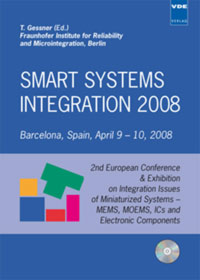Smart Micromachined Ultrasonic Probe with advanced imaging performances
Konferenz: Smart Systems Integration 2008 - 2nd European Conference & Exhibition on Integration Issues of Miniaturized Systems - MOMS, MOEMS, ICS and Electronic Components
09.04.2008 - 10.04.2008 in Barcelona, Spain
Tagungsband: Smart Systems Integration 2008
Seiten: 8Sprache: EnglischTyp: PDF
Persönliche VDE-Mitglieder erhalten auf diesen Artikel 10% Rabatt
Autoren:
Meynier, Cyril; Legros, Mathieu; Ferin, Guillaume; Nguyen-Dinh, An; Dufait, Rémi (VERMON SA, Tours, France)
Meynier, Cyril; Certon, Dominique (Inserm U930/CNRS FRE 2448, Tours, France)
Inhalt:
Generation of acoustic waves though capacitive effect is known for a long time. In the mid 90s, the very first demonstrators of electrostatic ultrasonic transducers were disclosed by B. Khuri-Yakub (Stanford University) and Siemens, and have been called CMUT standing for “Capacitive Micromachined Ultrasonic Transducers”. This was followed during the last ten years by a ramp-up of scientific and research and development activities through large increase of scientific articles and patents. Since CMUT devices are based on independently functional small membranes (few hundred of µm2), flexibility of topology and surface design are provided accordingly. Other advantage relating to these characteristics is that membrane surface and thickness govern directly the command voltage necessary for the vibration of membrane. Such high dielectric field combined with highly damped membrane in immersion operation, induced high electromechanical coupling coefficient and broad bandwidth response compatible with high resolution ultrasound imaging. The basic building block for a CMUT elementary cell is basically a capacitor with a free metallized membrane suspended over a fix bottom electrode. When a DC voltage (VDC) is applied to the parallel gap capacitor (membrane/cavity cell), an electrostatic force occurs between the opposite electrodes and causes deflection of the membrane – which presents a limit known as collapse. At this stage, if an alternative impulse (VAC) is added, the membrane will vibrate accordingly and then, generation of acoustic pressure is possible. Reversely, when a DC biased membrane is facing acoustic pressure impact, the output current due to capacitance variations is measured and the membrane is then operated as acoustic receptor. According to the above principle, the combination of a large number of elementary membranes connected together will form a transducing surface. There are typically hundreds of membranes on the surface of Megahertz range transducer element.


